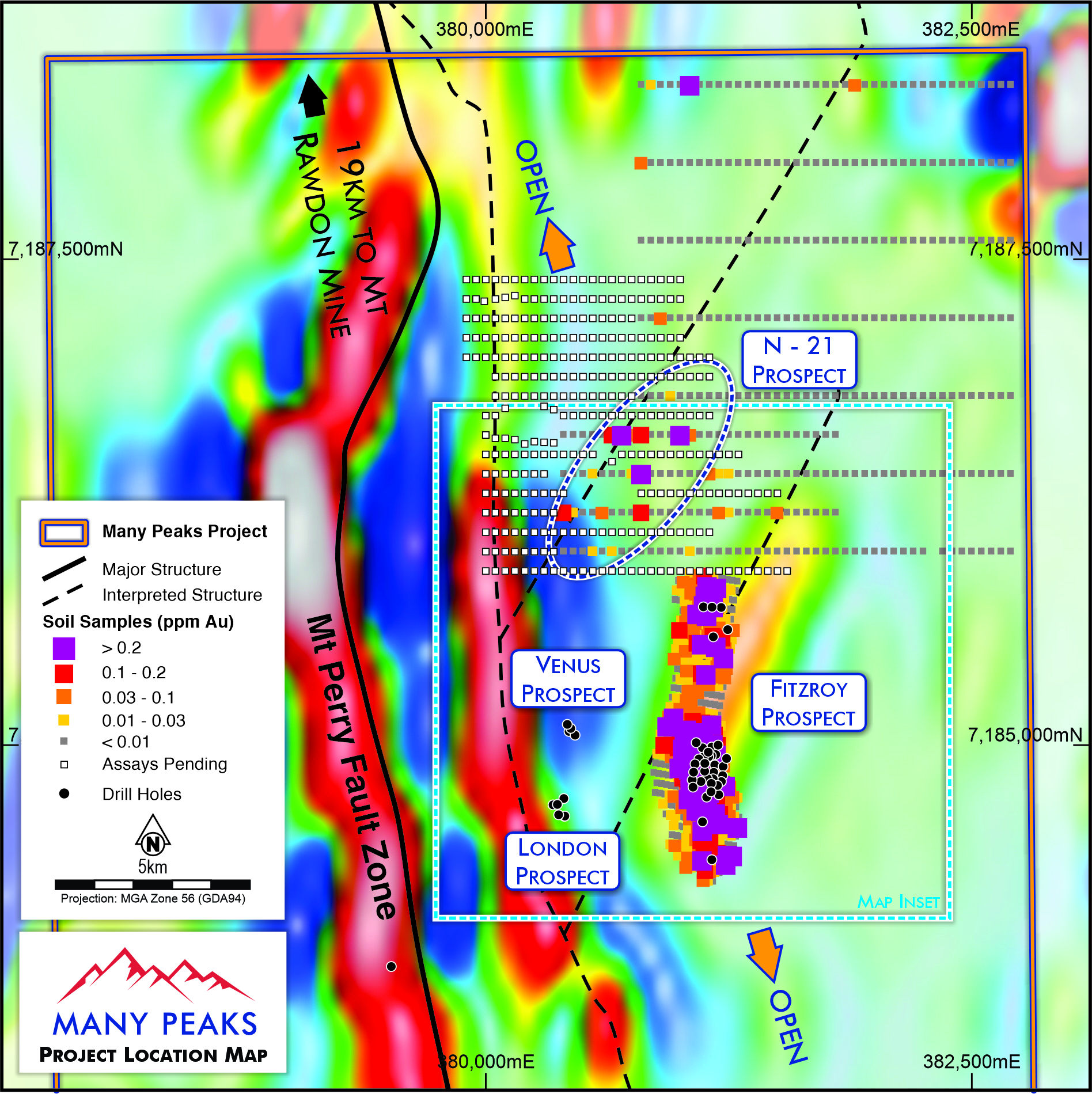Mt Steadman Gold Project Summary
Located 100km southeast of the Company’s Mt Weary Gold Project, the Mt Steadman project is a 56km2 holding, comprising of two granted exploration permits, covering an intrusion-related gold (“IRG”) system situated in the New England Orogenic Province 30km northwest of Biggenden, Queensland (Figure 1). The province is host to several IRG-type gold, porphyry and epithermal style deposits, including the Mt Rawdon deposit with a 2.3Moz gold endowment (Evolution Mining, 2023) located 19km to the north along the same Perry Fault system, a major structural feature in the area (Figure 2).
Various drilling campaigns completed from the mid 1990’s through the mid 2000’s tested limited strike extent and only support geological modelling of mineralisation to within 60m vertical extent from surface. The 49 historical drill holes reported to date average 84m in depth with the deepest drill hole on the project a RC drill hole to 157m drill depth. Mineralisation remains very much open at depth beneath previous drilling, and recent extensions to surface geochemistry work demonstrate potential for gold mineralisation along trend with recent extensions of soil survey work to the north of Fitzroy Prospect (Figure 2) identifying the “N-21” prospect returning results ranging from <1ppb Au to peak soil results of up to 0.75ppm and 2.17g/t gold at surface.
Mineralisation Style & Geology Setting
Mt Steadman partially covers the Chowey goldfield, which is host to numerous historical mineral occurrences including the underground workings at Mt Steadman, London, and Venus mines. The project is host to several outcropping zones of IRG style gold mineralisation associated with shear hosted quartz and broad zones of sheeted quartz veining. The land holding covers the Carboniferous aged Curtis Island Group, intruded by the Permian aged Chowey Granite, a multiphase intrusion where quartz hosted gold mineralisation is associated with aplites and monzonite porphyry compositions within the Chowey Granite stock.
Multiple stages of mineralisation have been identified at Mt Steadman. Gold occurs in various mineralising stages along north-trending quartz fissure veins oriented sub-parallel to the major Mt Perry regional shear direction at the London and Venus mine (Figure 1). Auriferous quartz veins also strongly correlate with bismuth and molybdenum with fine gold occurring between molybdenite laminae at the Venus Mine. From limited historical drilling around the London and Venus workings, better drill intercepts return;
Refer to MPK Release dated 2 May 2023
- 2m @ 110g/t gold from 20m – MS37
- 2m @ 12.5g/t gold from 8m – MS36
- 2m @ 4.88g/t gold from 55m – SRC02
At the Fitzroy Prospect, gold mineralisation is associated with a moderately east dipping zone of sheeted quartz veining hosted in the Chowey granite. The auriferous zone of sheeted veining varies from an estimated 4m to 33m in true thickness within a zone characterised by sericite-hematite alteration with minor chloritization that remains open along strike and at depth within two zones of shallow drilling with better historical drill intercepts returning;
- 22m @ 1.21g/t gold from surface – RC95MS10
- 25m @ 1.02g/t gold from surface – RC95MS04
- 19m @ 1.25g/t gold from 9m drill depth – RC95MS11
- 23m @ 1.04g/t gold from surface – RC95MS07
Figure 1: Mt Steadman Project Location on Central Queensland Project Map
Figure 2: Mt Steadman Project prospect locations on 1st derivative airborne magnetic dataset with surface soil geochemistry and drill collar locations
Figure 3: Drill Collar intercepts with significant drill intercepts and compilation of surface soil geochemistry results.
Mt Steadman, Exploration History
The Mt Steadman mines (Mt Steadman, Venus and London) were initially worked in the 1880’s with the most significant and continuous period of operations between 1891 and 1902 followed by sporadic production reported from the 1920’s to 1940’s.
In the 1990’s Mt Steadman was the focus of more modern geochemical, and geophysical exploration campaigns followed by shallow reconnaissance drilling programs that recognised extensions to undeveloped quartz vein hosted gold mineralisation proximal to historical mines. Further follow-up drilling to ground geophysics and surface geochemistry work culminated in the discovery of the outcropping sheeted veins at the Fitzroy Prospect east of the Mt Steadman mines. Shallow drilling completed in the mid 1990’s underpinned modelling of mineralisation to approximately 60m vertical depth and highlight that mineralisation remains open in all directions.
Historical drilling totals 4,112m of reverse circulation and diamond drilling from 49 averaging 84m in length with only 6 holes to date exceeding 130m drill depth. Reported collar locations, geological logs and assay results are available in various annual activity reports with the Geological Survey of Queensland, however with no sample material preserved for inspection
Little drilling activity for gold has taken place since that time and insufficient drilling material is retained for validation work to update previous estimates in accordance with the principles of the 2012 edition of the JORC Code. EMX Royalty Corp (TSX.V:EMX) initiated validation work, completing two confirmatory diamond drillholes within the footprint of previous drilling. Drill holes DD22-YA187 and DD22-YA188 totalling 218m of diamond drilling were drilled as part of a 50 hole program at Yarrol in recent months, returning:
Each hole intersected mineralisation associated with the main diorite intrusion. However, recent observations indicate that various other phases of intrusions and surrounding sediments are also mineralised with further work required to define key structural controls on mineralisation. It is also notable that the selected sample intervals taken from drill holes DD22-YA187 and DD22-YA188 began and ended in gold mineralisation and additional intervals will be sampled and analysed from both holes.






